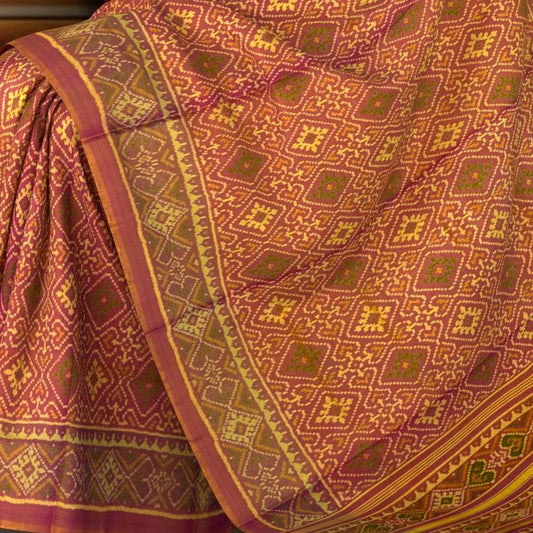Seasonal Trends in Patola Saree Care: Expert Tips for Repair, Restoration, and Longevity
Patola sarees, with their intricate designs and vibrant colors, are a timeless treasure in the world of fashion. These sarees, known for their double ikat weaving technique, are not just garments but pieces of art passed down through generations. However, like all cherished items, Patola sarees require careful maintenance to preserve their beauty and longevity. In this blog post, we will delve into seasonal trends in Patola saree care, focusing on repairing minor damages, restoring vintage pieces, and adopting preventive measures to ensure these sarees remain stunning for years to come.
1. Repairing Minor Damages and Tears
Patola sarees, despite their durability, can suffer from minor damages and tears due to regular use or improper handling. Addressing these issues promptly can prevent further deterioration and extend the life of your saree.
Identifying Common Damages
Common issues include loose threads, small tears, and frayed edges. Regular inspection of your saree can help you spot these problems early. Pay particular attention to areas that experience more stress, such as the edges and the pleats.
DIY Repair Techniques
For minor damages, you can often perform simple repairs at home. Here are some tips:
- Loose Threads: Use a needle to gently pull loose threads back into the weave. Be careful not to pull too hard, as this can cause more damage.
- Small Tears: For tiny tears, use a matching thread and a fine needle to sew the edges together. Make small, tight stitches to ensure the repair is secure and less visible.
- Frayed Edges: Prevent further fraying by applying a fabric adhesive to the edges. This will help keep the threads in place without altering the appearance of the saree.
Professional Repair Services
For more significant damages, it’s best to seek professional help. Experienced weavers and tailors who specialize in traditional textiles can expertly mend your Patola saree without compromising its original design. Investing in professional repair services can save your saree from irreversible damage and maintain its value.
2. Restoring Vintage Patola Sarees
Vintage Patola sarees are family heirlooms that carry historical and emotional significance. Restoring these pieces requires a delicate balance of preserving their original charm while reinforcing their structure.
Assessing the Condition
Before beginning any restoration work, assess the condition of the saree. Look for signs of wear, such as discoloration, weakened fabric, and extensive tears. Understanding the extent of the damage will help you determine the best restoration approach.
Cleaning and Reviving Colors
Over time, vintage sarees can lose their vibrancy due to dust and dirt accumulation. A gentle cleaning process can help revive the colors:
- Dry Cleaning: Always opt for professional dry cleaning services that specialize in handling delicate fabrics. Inform the cleaners about the saree’s age and material to ensure appropriate care.
- Home Cleaning: If professional services are not accessible, you can clean the saree at home. Soak the saree in lukewarm water with a mild detergent for a few hours. Gently agitate the water to loosen dirt, then rinse thoroughly. Avoid wringing or twisting the saree, as this can cause damage.
Reinforcing the Fabric
Weak or thin areas of the saree can be reinforced by adding a backing fabric. Choose a fabric that matches the saree’s texture and weight to maintain its original feel. This process should ideally be performed by a professional to ensure precision and care.
Restitching and Repairing Embellishments
Vintage Patola sarees often feature intricate embellishments that may need restitching. Use threads that match the original colors and patterns. For complex designs, seek the expertise of a skilled artisan to preserve the authenticity of the work.
3. Preventive Measures to Prolong the Life of Patola Sarees
Preventive care is crucial for maintaining the beauty and durability of Patola sarees. By following these simple steps, you can ensure your sarees remain in excellent condition through the seasons.
Proper Storage
- Cool, Dry Place: Store your Patola sarees in a cool, dry place away from direct sunlight. Excessive heat and moisture can weaken the fabric and cause colors to fade.
- Breathable Storage: Use breathable cotton or muslin bags to store your sarees. Avoid plastic covers, as they can trap moisture and lead to mold growth.
- Fold with Care: When folding your saree, place acid-free tissue paper between the folds to prevent creases and protect the fabric.
Regular Inspection
Periodically inspect your sarees for any signs of damage or wear. Early detection of issues like loose threads or tiny tears can prevent more extensive damage. Addressing these problems promptly ensures your saree remains in top condition.
Avoiding Harsh Chemicals
When cleaning your sarees, avoid harsh chemicals that can damage the fabric. Stick to mild detergents and gentle cleaning methods. Always perform a patch test on a small, inconspicuous area before using any new cleaning product.
Mindful Wearing
- Jewelry and Accessories: Be cautious when wearing jewelry or accessories with your Patola saree. Sharp edges can snag the delicate fabric, causing tears or pulls.
- Handling with Care: When draping and handling the saree, do so gently to avoid unnecessary stress on the fabric. Avoid stepping on the pleats or pulling on the pallu.
Seasonal Care
Different seasons bring different challenges for fabric care. Here’s how to adapt your saree care routine based on the season:
- Summer: In hot and humid conditions, ensure your storage area is well-ventilated to prevent mold growth. Regularly air out your sarees to keep them fresh.
- Monsoon: During the rainy season, avoid exposing your sarees to excessive moisture. Use dehumidifiers or silica gel packets in your storage space to absorb excess moisture.
- Winter: In colder months, ensure your storage area remains dry and free from dampness. Keep your sarees away from heaters or direct heat sources to prevent fabric damage.
Conclusion
Patola sarees are more than just garments; they are embodiments of tradition, artistry, and heritage. Caring for these sarees requires a blend of attentive repair, thoughtful restoration, and proactive preventive measures. By following the expert tips outlined in this guide, you can ensure your Patola sarees remain as stunning and vibrant as the day they were crafted. Embrace these seasonal trends in saree care and preserve the legacy of your cherished Patola sarees for generations to come.
- bridal sarees
- bridal silk sarees
- cultural
- cultural diversity
- culture
- diversity
- double ikat
- ethnic wear
- fabrics
- fashion
- fashion shows
- fashion statement
- global allure
- global runway
- gujarat patola
- handloom
- handloom love
- handloom sarees
- handmade
- handmade sarees
- handwoven
- handwoven saree
- heritage
- ikat
- indian culture
- indian fashion
- indian films
- indian sarees
- indian textiles
- indian wedding
- kanchipuram silk
- kanchipuram silk sarees
- kanjivaram silk sarees
- luxury silk sarees
- muga silk
- muga silk saree
- patola
- patola sarees
- patola silk
- patola silk sarees
- pochampally
- pure silk
- pure silk sarees
- silk
- silk saree
- silk saree collection
- silk sarees
- silk sarees collection
- silk sarees online
- silk weaving
- silkworms
- tussar
- tussar silk saree
- vocal for local
- weave
- weavers
- weavers of india
- weaves of india
- weaving
- weaving industry
- women weaving







Leave a comment
Please note, comments need to be approved before they are published.